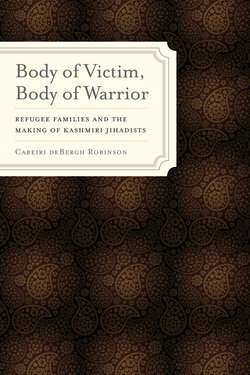Читать книгу Body of Victim, Body of Warrior - Cabeiri deBergh Robinson - Страница 9
ОглавлениеNOTE ON NAMES, TRANSLITERATION, AND PHOTOGRAPHS
In this book, I refer to the distinct governmental regions of the disputed territory of Jammu and Kashmir by the names by which they are identified in their own current constitutional documents. In Pakistan, the State of Azad Jammu and Kashmir is commonly referred to as “Azad Kashmir” (Free Kashmir) and in India it is known as “POK” (Pakistan Occupied Kashmir). I employ its full constitutional name except when I am presenting ethnographic materials, in which case I reproduce names like “Azad Kashmir” and “Occupied Kashmir” in order not to distort the speakers’ intentions. For the sake of consistency and clarity, I refer to its government as the government of Azad Jammu and Kashmir. Likewise, I refer to the 1949 UN Ceasefire Line as the military “Line of Control,” even though it wasn’t officially renamed until the Simla Agreement of 1972.
Following anthropological convention, I use pseudonyms in my presentation of all ethnographic information. For unmarried youths and young men, I use only a single name. I use two names for older men to whom I owe the respect due to an elder, but in order to avoid the confusion that would result from using a fictive second name linked to descent-group identities, I use two male first names. Women generally have as a second name the first name of their father or of their husband; I use the second name “Bibi” for younger women and “Begum” for elder women. In my presentation of historical material, such as documents or memoirs, I use real names as recorded in the public or governmental record.
Transliteration of Urdu words follows the system standardized by John T. Platts in A Dictionary of Urdū, Classical Hindī, and English and reflects the standard spelling of the word as it is written. I do not use diacritical markings in any personal names, proper nouns, or adjectives generated from proper nouns (such as “Kashmiri” or “Pakistani”) unless they are a part of an Urdu language phrase. In the case of political parties and militant organizations for which there are several alternative English transliterations in use, I employ a common one. The term jihād has entered into English-language usage in the past decade. As an English word, jihad is used to refer to Islamic religious warfare. As an Islamicate word, however, the term has a more variegated meaning; it can refer to a struggle in either spiritual or material realms. In this text, I retain the hard diacritic to mark the fact that it has also become a dialectical term, jihād, which refers simultaneously to its use within specific Muslim societies and to its integration into a global political vocabulary. I use the term as a foreign word (jihād) to mark its use (1) as an ethnographic distinction within translated ethnographic quotes to draw attention to the speaker’s original use of the term; and (2) as a purely Islamic concept in religious texts. I deploy a grammatically unconventional plural in this text to make another ethnographic distinction; muhājirīn is the correct grammatical plural of muhājir (refugee) and mujāhidīn of mujāhid (warrior), but I use English plurals (muhājirs and mujāhids) to indicate a plurality of individuals as opposed to a collectivity. This is an important distinction in the greater Kashmir context, where people use a singular noun with a plural verb to mean groups of individuals; for example, “yeh lōg mujāhid haiñ” (those people are mujāhids). Thus, I use the word mujāhids when many individual militants are involved, but I use the word mujāhidīn when referring to a collective of militants acting or speaking as members of an organization.
I took all photographs used in this text. I have not used any photographs depicting people in close-up focus because of issues of confidentiality. For the same reason, names and identifying data have been removed from the document facsimiles reproduced here.
